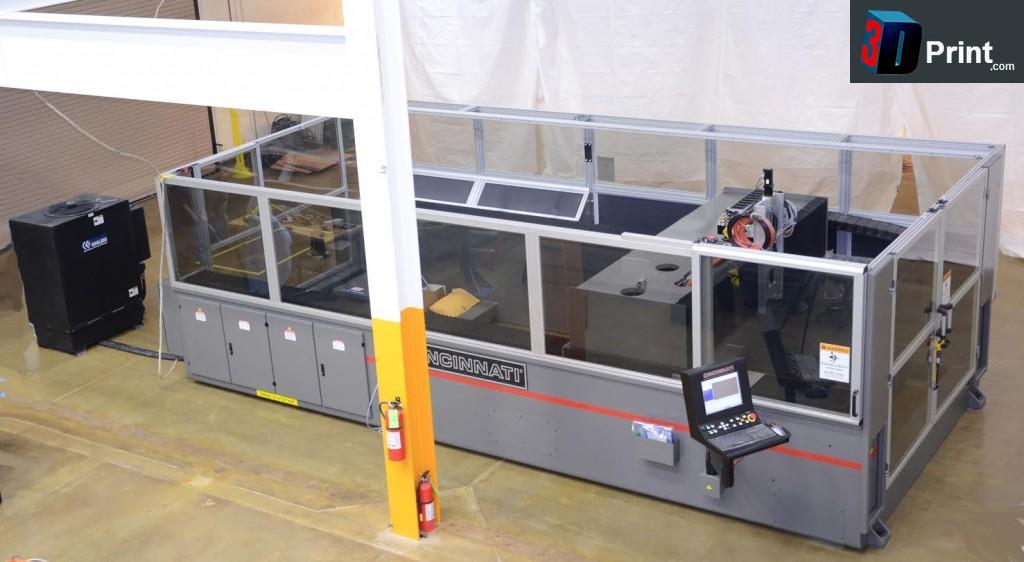Back in February the U.S. Department of Energy’s Oak Ridge National Laboratory (ORNL), and Cincinnati Inc. set quite a goal for themselves within the 3D printing space. They set out to create a 3D printer which would be capable of printing at speeds of over 200 times that of traditional printers on the market at that time. If the magnitude of such a seemingly far fetched goal did not impress you, then the fact that they also wanted to make this machine 10 times larger than most of the other printers out there, could have.
In the months since ORNL and Cincinnati Inc. launched their initiative, the initial buzz pertaining to what they were working on, died down, but hasn’t been forgotten. Such a machine, if possible, would surely send shivers down the spines of traditional manufacturers, who could be left with the option to adopt such technology or lose a bulk of their business to those who do.
Because of my extreme curiosity of this matter, I decided to reach out to Rick Neff, manager of market development, for Cincinnati Inc., to see what kind of progress they have been making, and to get some more information on this project. Neff explained the technology behind Cincinnati Inc.’s big area additive manufacturing (BAAM) machine:
“BAAM is a FDM machine on steroids. We use feed stock of plastic pellets like [those] used in an injection molding machine, so it is affordable for large production parts. At over 10 pounds per hour of ABS plastic it is several orders of magnitude faster than other typical FDM systems. We sacrifice some accuracy and detail for speed.”
 When I asked Neff about their goal of creating a printer capable of printing at speeds 200 times that of traditional machines, to my surprise, he informed me that the prototype gantry of their BAAM machine is already capable of such a task. The company is also working on ways to create smooth finishes on objects, since the resolution of the actual prints are lacking some quality, due to the large size of the print nozzle (0.3 inches). Neff was also kind enough to provide us with an image (left) showing a 3D printed table and chairs, that were on display at RAPID 2014 last week. He said that each chair took approximates 150 minutes to print on their BAAM machine.
When I asked Neff about their goal of creating a printer capable of printing at speeds 200 times that of traditional machines, to my surprise, he informed me that the prototype gantry of their BAAM machine is already capable of such a task. The company is also working on ways to create smooth finishes on objects, since the resolution of the actual prints are lacking some quality, due to the large size of the print nozzle (0.3 inches). Neff was also kind enough to provide us with an image (left) showing a 3D printed table and chairs, that were on display at RAPID 2014 last week. He said that each chair took approximates 150 minutes to print on their BAAM machine.
There is still a lot of work to be done on this project, but if you are like us, you will likely be quite surprised at the progress which has been made. They expect to begin taking orders for production machines around the end of the year, but according to Neff, they are not ready to publicize a price point for their BAAM machines.
Whether this type of 3D printer takes off or not, is yet to be seen. Neff himself understands that there are still some question marks around this type of technology, stating:
“We are not sure if there is a market for a machine this big. It is very different from anything in the industry. Not sure where it will be in 5 years. We have the capability of building just a few machines annually or many machines, depending on what the market needs.”
Clearly, such a machine could be a game changer, not only within the large scale 3D printer space, but also within the entire manufacturing industry as a whole. The ability of Cincinnatti Inc. to improve upon this already seemingly amazing technology, and provide it at a market friendly price, will determine just how far these machines go. Below you will find a picture of the latest BAAM 3D printer. As you can see, it is enormous. Let us know what you think about these revelations, and what they could mean for the manufacturing industry in the long run. Discuss it with our community in the BAAM 3D Printer forum thread at 3DPB.com.
Subscribe to Our Email Newsletter
Stay up-to-date on all the latest news from the 3D printing industry and receive information and offers from third party vendors.
You May Also Like
Profiling a Construction 3D Printing Pioneer: US Army Corps of Engineers’ Megan Kreiger
The world of construction 3D printing is still so new that the true experts can probably be counted on two hands. Among them is Megan Kreiger, Portfolio Manager of Additive...
US Army Corps of Engineers Taps Lincoln Electric & Eaton for Largest 3D Printed US Civil Works Part
The Soo Locks sit on the US-Canadian border, enabling maritime travel between Lake Superior and Lake Huron, from which ships can reach the rest of the Great Lakes. Crafts carrying...
Construction 3D Printing CEO Reflects on Being Female in Construction
Natalie Wadley, CEO of ChangeMaker3D, could hear the words of her daughter sitting next to her resounding in her head. “Mum, MUM, you’ve won!” Wadley had just won the prestigious...
1Print to Commercialize 3D Printed Coastal Resilience Solutions
1Print, a company that specializes in deploying additive construction (AC) for infrastructure projects, has entered an agreement with the University of Miami (UM) to accelerate commercialization of the SEAHIVE shoreline...































